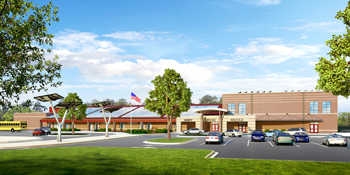Architects Deliver on P3 Promises
 RALEIGH, N.C. — SfL +a Architects have announced the approval to build Sandy Grove Middle School, the first public-private partnership (P3) financed school in North Carolina and the second of its kind in the U.S.
RALEIGH, N.C. — SfL +a Architects have announced the approval to build Sandy Grove Middle School, the first public-private partnership (P3) financed school in North Carolina and the second of its kind in the U.S.
SfL +a has been advocating for the P3 method at both the university level as well as K-12, according to Robbie Ferris CEO/president of the firm.
“We did the first public-private partnership for a university housing project in North Carolina back in 2000, and then in 2006 we were instrumental in legislation passing to allow that to happen at the K-12 level. We’ve really developed the business model that adds value to the school systems for the county.”
Five years ago, the Hoke County School District requested a new school to be built, with no intention at the time of implementing a P3 method. When the economy took a dive, the project was put on hold until February 2011 when the school system came back to SfL +a to find a way to continue construction.
“I said to them, why don’t we deliver it as a public-private partnership. And so we went through a year of due diligence, getting the stakeholders on board with the idea of doing something new and then starting construction,” said Ferris.
The 74,000-square-foot school will be a net-zero facility, returning more energy to the grid then it consumes, as well as a LEED Gold certified building, according to a statement.
Design and construction features will include geothermal heating and cooling systems, spray foam installation, solar panels, high efficiency lighting, and a whole-building generator.
“We are incredibly excited about getting this project, we see it as a defining moment in the history of our company. We’ve been able to do something that we’ve been wanting to do for the last six years. This is going to set a new standard for the development of schools in North Carolina and maybe beyond,” said Ferris.
Construction started on June 28 and is expected to last one year, with the school moving into the building August 2013 in preparation for the academic year.
Funding from the project is coming from a Qualified School Construction Bond Allocation (public) and new market tax credits (private), with a total project cost of $23 million. Renewable energy tax credits will also fund a portion of the project.
